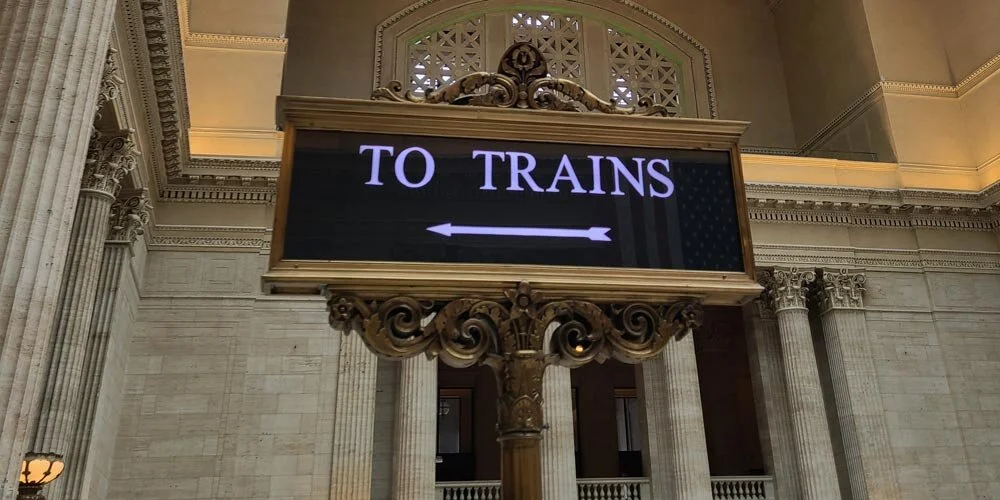What I Learned on My 28 Hour Trip through the Supply Chain
Recently, I was able to check off one of my long-time bucket list items; taking a cross-country train trip from Chicago to Glenwood Springs CO on the Amtrak California Zephyr. There’s always been something romantic about the idea of train travel and it's traditions dating back to its golden age almost 100 years ago. Today, although rail is seen as more of a utilitarian way to travel, it is certainly no less unique. To my surprise, this journey also provided a close-up view of parts of the country that simply aren't accessible from a highway or an airport terminal.
Given that I’ve spent the last 20 years of my career in supply chains, it was only natural to reflect on the state of today’s supply chain while literally riding on one of the critical components of the modern global supply chain infrastructure. There were a few key takeaways from the experience that caused me to step back and reevaluate what actually matters in this industry.
The majestic California Zephyr, in all its glory
Start Locally With People
It’s a cliché that America is mostly small towns, but seeing it up close explains why that is. When taking a train across the country, there’s one thing that you are certain to see over and over again; grain elevators. It seemed that every stop, every town has a grain elevator on a rail spur that anchors it. Exciting stuff, right? Well it's more than just a relic of the past.
While there's a seemingly endless parade of grain elevators, each one represents the link between the people that grow the food and the supply chain that manufactures it. As someone that has worked in food and beverage most of his career, it was humbling to be reminded that the supply chains don’t start with some vague commodity, but the people whose routines, towns and livelihoods center around these grain elevators and their respective transit systems to connect with the greater global supply chain. Thousands of these structures still exist across the country, and each one has a town, a history and a people attached to it. I won’t forget that anymore.
Conflict on Scarce Resources
There’s a conflict out there on a resource that started over 100 years ago. Rail is suddenly a hot commodity again. It’s an efficient way to transport goods, and it’s gaining traction as a viable transportation alternative in our new infrastructure plan. That’s great news.
However, it's important to note that there’s not more rail than there was before. It’s still the same tracks, owned by freight lines, that will get more important and more scarce as demand increases. And given the number of times we were delayed waiting for freight traffic, it was apparent that they're going to need some solutions sooner rather than later.
Fragility of the Infrastructure
So much of this part of the country looks old. The towns, barns, and equipment along this route were all showing their age. Only the aforementioned grain elevators (that are owned by the large conglomerates) are lucky enough to have a fresh coat of paint. These places only function as the entry point to the global food supply chain as long as there are people and families on the other side to fill them.
I don’t have any sort of magic bullet solution here, but it feels like small town America could certainly use some attention. The infrastructure of roads, broadband, equipment, and transportation all need to be directed to this part of the country in order to help support these communities.
Some of it might come from government intervention, like widely available broadband. However, it might just need drastic changes in policy concerning food prices and subsidies to the large manufacturing conglomerates. There's no easy answer, but the situation poises a lot of questions, and will require innovative solutions in order to keep many of these communities afloat. Our friend Zach Cain (a real, actual farmer!) covered these issues in-depth in an episode of our SCM Connections podcast.
From the plains, up through the mountains
Infrastructure is Forever
The counter argument to these perceived difficulties is that investments in infrastructure are forever. As we wound our way through the midwestern plains and towards the mountains, our conductor pointed out landmarks and towns left over by the people that built the railway over 150 years ago.
It’s hard to fathom the sacrifice of lives, fortunes and resources that took place in just a few short decades. Those sacrifices are evident in the 27 tunnels we passed, those which were crafted by carving through solid rock, including the longest tunnel in existence all to give us the ability to climb thousands of feet over the rocky mountain range in relative comfort.
Humans tend to invest in the short term, but it’s humbling to be reminded of how the decisions we make today will reverberate throughout history for generations to come.
SCM Connections COO Kristi Naidech celebrates the end of a successful journey
Overall, our voyage on the Zephyr was certainly a memorable trip. It provided time to reflect on an often unacknowledged side of our country, one that still functions as the backbone for many parts of the economy, and of the supply chains that are rarely front and center. I highly recommend this experience for those who are interested in stepping back from their daily routine to see this for themselves, and welcome any thoughts of those who have shared that journey before.





